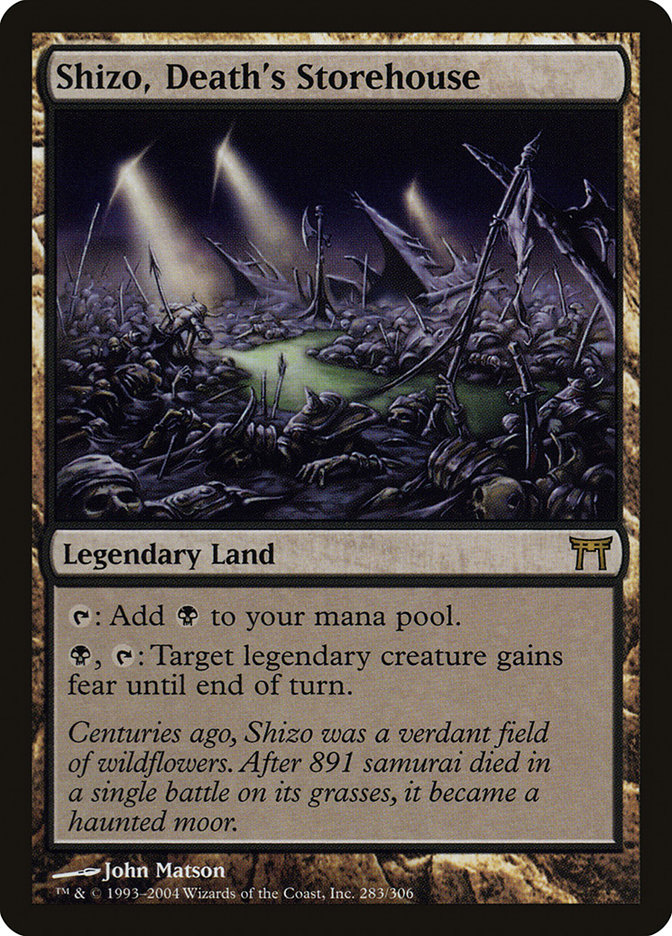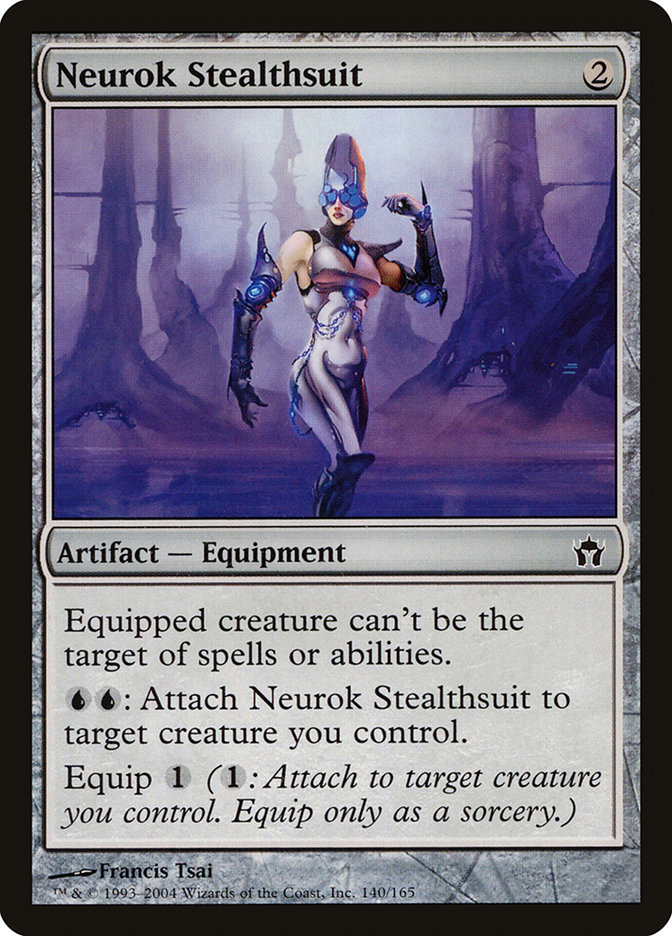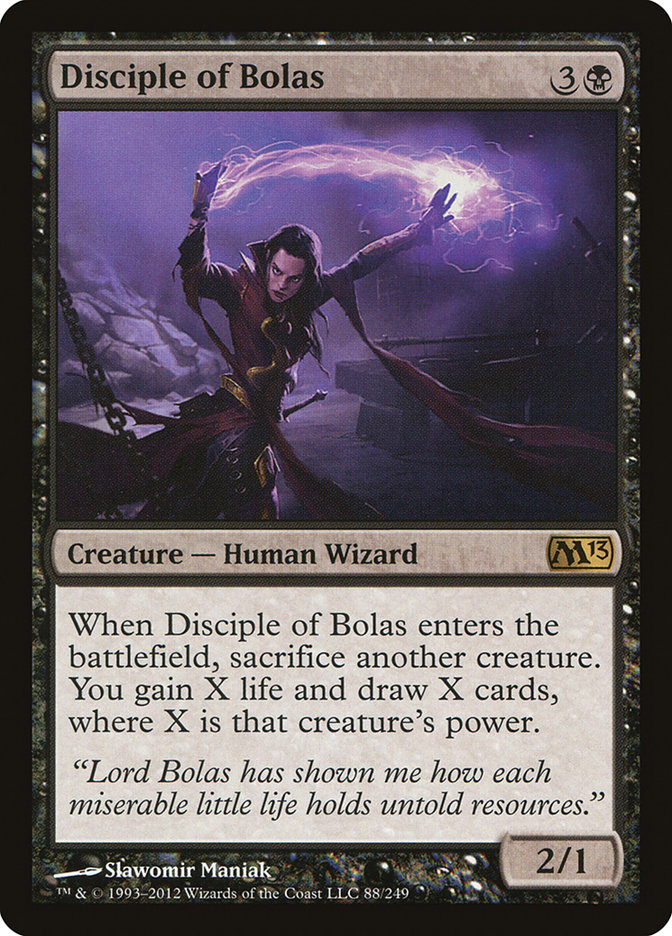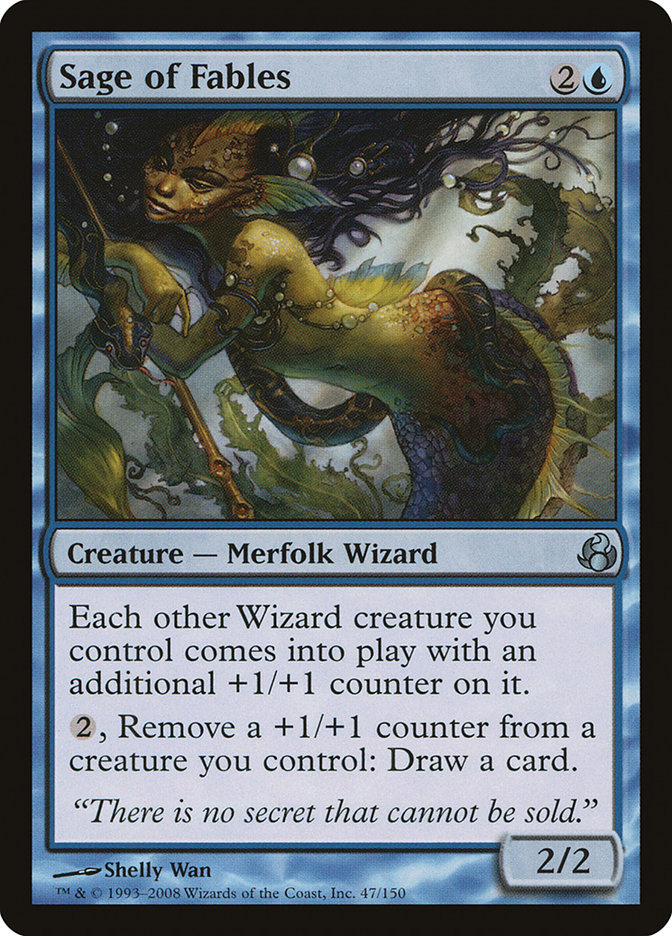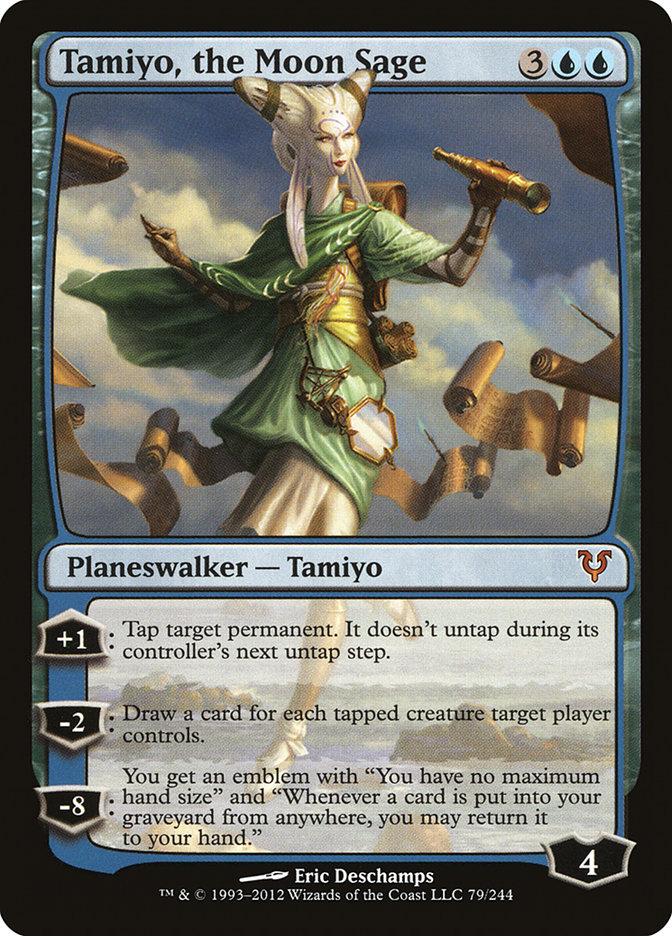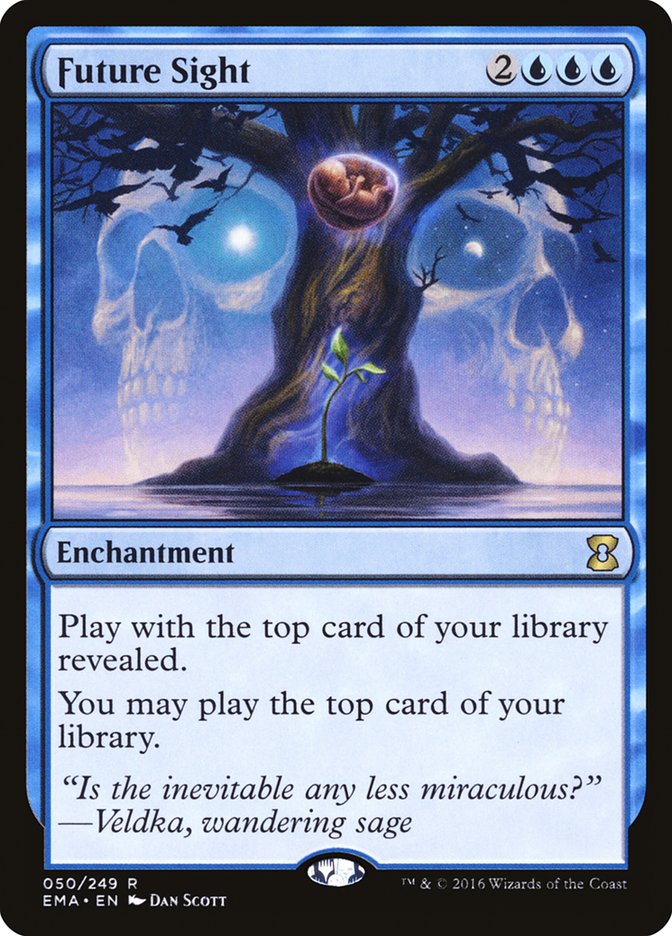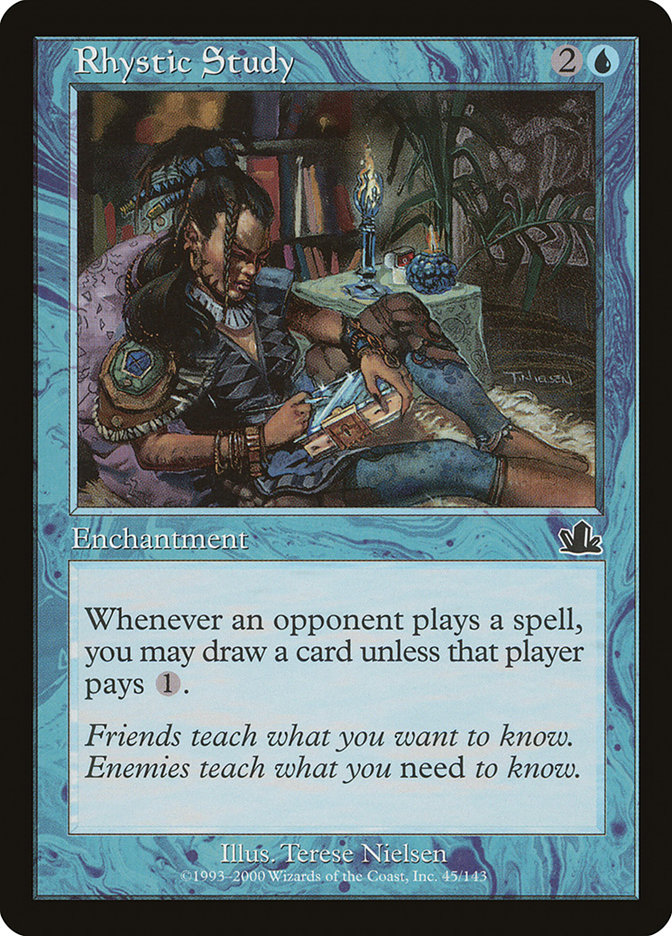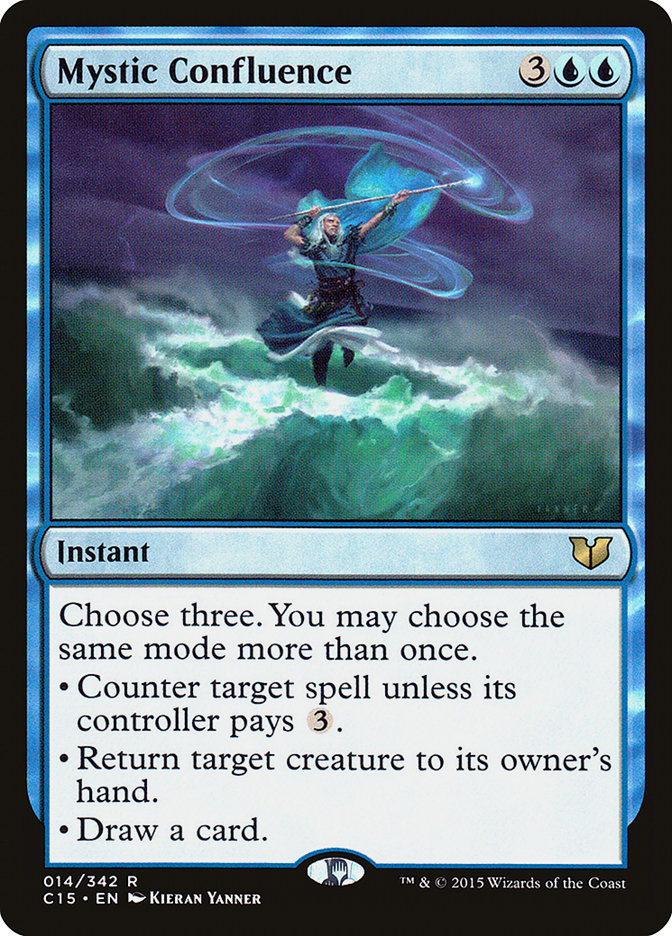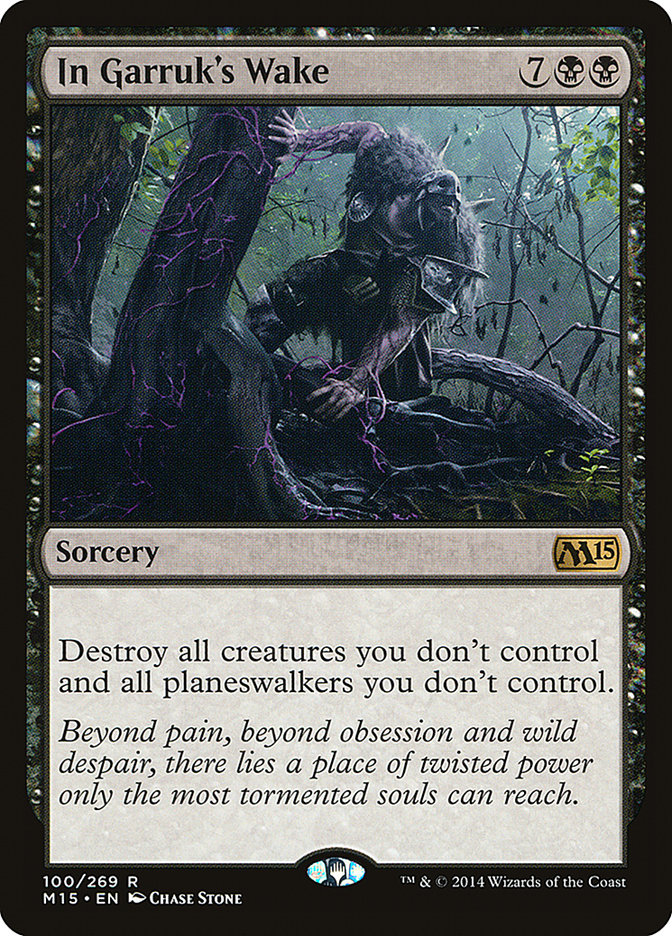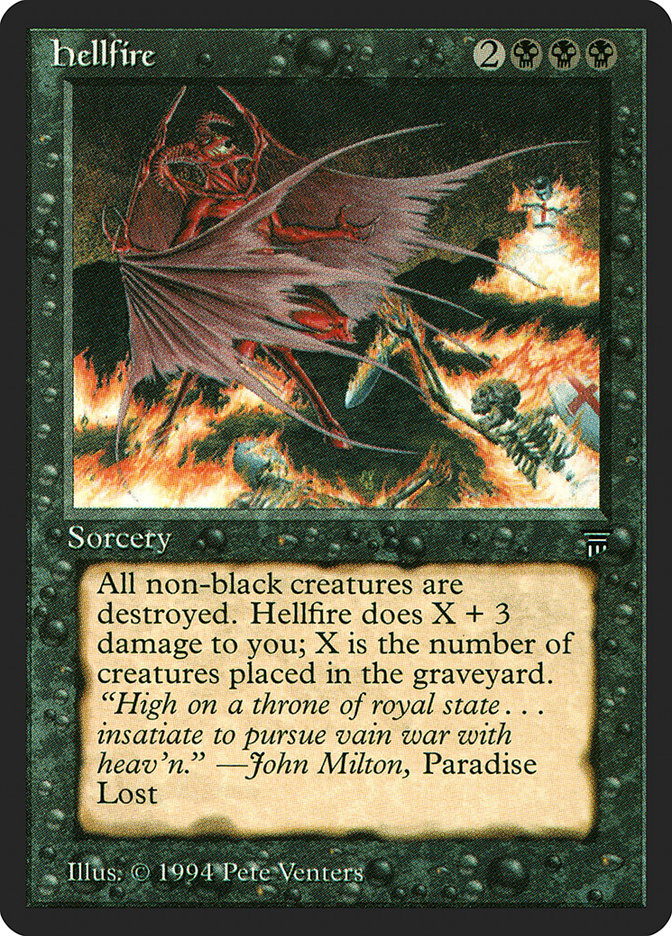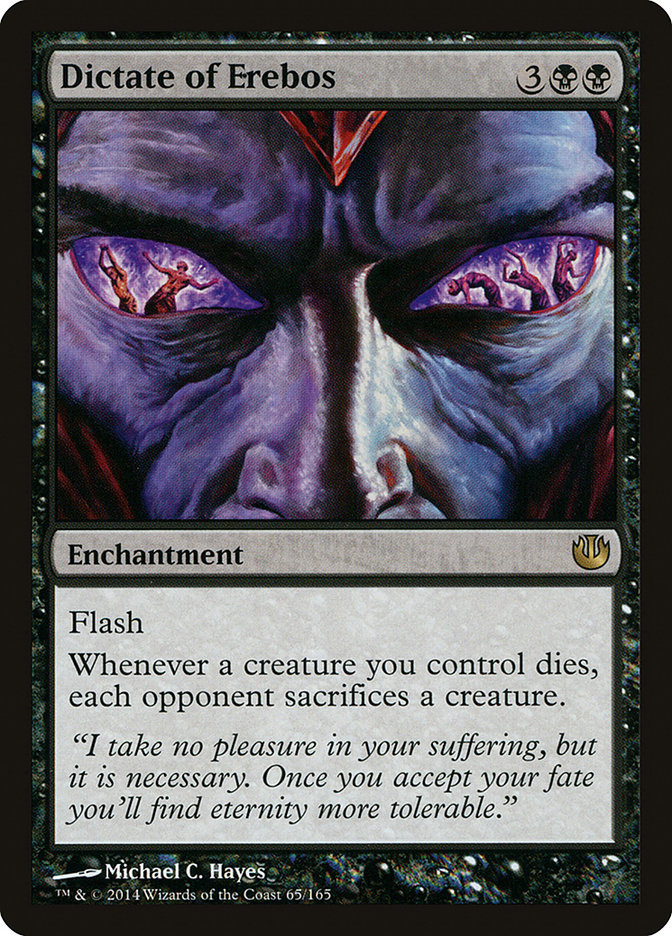Dear Azami,
An old friend donated his Magic collection to me a while ago as he no longer plays with anyone but me. Soon this friend will become my roommate, and I have been trying to brew up a Tribal Vampire deck to replace his older underpowered deck so he can participate in the weekly Commander games that I host and feel competitive. His old deck was B/R with Olivia Voldaren at the helm, and the new version adds blue mostly for interaction and utility.
The vision for the deck is an aggressively-slanted midrange deck without any combos. I am unsure how many complicated cards should or can go into the deck as my friend I quite rusty on the rules. That being said, we could always explain it to him as he goes… it’s more important that the deck prioritize synergy and making interesting and cool plays rather than being simple to play.
I have never brewed up a successful Tribal deck before and I humbly ask for your advice in refining this list. I’m not sure if it’s looking for more recursion, kill spells, ways to get more aggressive, or that little something extra.
Thank you,
Remington
Commander: Marchesa, the Black Rose
(Yeah, I know she’s not a Vampire, but she seems really synergistic with what they’re trying to do.)
Creatures:
Spells:
Artifacts:
Lands:
3x Island
Minamo, School at Water’s Edge
3x Mountain
4x Swamp
Tribal decks without a member of the tribe at the helm are always a little complicated, but with Marchesa’s Dethrone ability neatly meshing with the recent Vampire mechanics fixated around +1/+1 counters, I think she’ll be a reasonable fit. I want to play with those counters a little bit more, but really doing so takes us far off-theme from the Tribal element… a little taste will have to suffice, like finding room for a copy of Sage of Fables even though most of the Vampires are not also Wizards, simply because the card-drawing power of that card, when meshed with everything else you’re doing, is too powerful to deny.
Mostly I think the deck just needs streamlining, cutting the B-list Vampires and the most obvious “good stuff” spells in order to build in a more cohesive plan of action. The deck needs some more card drawing in order to keep up, could benefit from finding room for one-sided sweepers to help overpower the opponent, and wants a bit of a higher curve so that we’re drawing powerful seven-drops instead of Falkenrath Gorgers in the later stages of the game.
The manabase is obviously great; decks full of two-color lands should have no problems finding their colors. If anything, I think this deck could use a few more basic lands to help make sure the two-color land cycles like Sulfur Falls and Smoldering Marsh enter the battlefield untapped on time, and I’m willing to cut Temple of the False God, Evolving Wilds, and Terramorphic Expanse to get there.
This only effectively ups your basic land count by one, it’s true, but it also removes two lands that naturally come into play tapped to replace them with lands that don’t… and cuts the one land in your deck that does nothing until turn 5 because the deck is focused on making its early plays rather than trying to cast six-drops a turn early. I also want to cut that Reliquary Tower, because frankly the deck doesn’t have enough card-drawing going on to really warrant its inclusion, but I want to add two lands back into the deck so we can get the land count up to 37:
There are plenty of legendary creatures in this deck, so Shizo’s evasion ability will be quite useful at making sure Drana, Liberator of Malakir connects with the opponent or that Kalitas, Bloodchief of Ghet can safely attack to buy back a few life points. Marchesa really values being able to safely attack in order to turn on her built-in protective ability, and it’d be a shame to have to hold back with your shields down just because there wasn’t an opening.
We’re just adding Bojuka Bog here to cover a weakness – this build is focusing on building up its side of the battlefield and pays no attention to an opponent’s graveyard, so adding a land that at least gives us a hope of breaking a tough recursion chain is well worth the slot.
Normally when moving on to the artifacts I’d strongly want to cut the Signets, but considering how sweet the four-spot is in this deck, I actually quite like them here and even want to add a Mind Stone to go with them – it’s a better fit than Chromantic Lantern simply for curve reasons, and most of the lands in this deck already tap for two colors of mana anyway. The Gilded Lotus however is a poor fit – you’d rather spend that turn deploying a threat, since the four-to-six-drop slot is where this deck seems to shine, and playing an expensive ramp card doesn’t really accomplish much here. I trimmed its slot to fit in that extra land to begin with.
As much as Blade of the Bloodchief is on-theme for the “games with +1/+1 counters and being a Vampire matters,” I don’t think it’s actually doing anything beneficial here, even if it does provide that effect at a solid rate. The typical “default” first Equipment card in a deck like this would be Lightning Greaves for its particular mix of increasing the speed at which you deal damage and beneficial protection, but here I’m tempted to go with a corner-case gem I sometimes like to employ specifically because of how important it is to keep Marchesa on the table.
Neurok Stealthsuit is great at thwarting targeted removal, providing you with the recurring value of a Counterspell without having to have one in hand. I don’t actually think Counterspell is good enough for this format, but having a situational Counterspell always at the ready is a solid effect. It doesn’t matter that the effect is limited when it nonetheless covers the large bulk of things you care about protecting, and I think keeping your creatures on the battlefield will be more relevant than collecting some additional counters on one of them whenever something dies.
Your creatures require a good bit of sorting out – I appreciate that Keranos and Thassa are present for their special abilities rather than as creatures, but I’d rather play a straight-up card advantage creature in those slots than to rely on small incremental bonuses accruing over time. Other than that, we’re just going to cull the worst Vampires in order to realign your threat base into something a bit harder-hitting. First the cuts:

We’ll be replacing Thassa and Keranos with other card-advantage creatures so it’ll all work out in the end. I wanted to increase the deck’s card flow from slow and incremental to fast and powerful instead. While Snapcaster Mage is good, it doesn’t really fit; your spells are mostly sorceries and reactive instants and you lack the ability to sacrifice creatures for fun and profit, so recursion via Marchesa will tend to happen only on other players’ turns after they’ve played a battlefield wipe. Just as a creature by itself, it’s not carrying enough weight and would be better off as a Vampire.
Without the ability to sacrifice your own creatures en masse on command, this is not really a good home for Blood Artist, even though it is a Vampire. Falkenrath Gorger is getting cut because Jackal Pup is not a great Commander card and we’re not positioned to turn that madness ability into a real advantage, and Mirko Vosk’s milling ability is as likely to help an opponent as hurt them. Graveyards are almost like a second hand in this format to many decks, so dumping a bunch of resources there can be a lot like letting an opponent draw a lot of cards… fine as a drawback on the creature in order to get a good rate, since it isn’t always guaranteed to benefit an opponent, but with its intent being that this is the primary advantage of the creature, we can do better than a 2/4 flier for our troubles.
Adding back in, I have seven cards to add, so we’ll end up cutting a spell at the end to make it all fit. The two non-Vampires I want to add are these:
This deck has plenty of ways to get +1/+1 counters, but Marchesa only needs a creature to have one on it in order to return it to the battlefield. Sage of Fables thus can convert the Vampire tribe’s ability to gain +1/+1 counters into a card-drawing tool rewarding you for attacking your opponents. Even though only a handful of your Vampires will count as Wizards for the Sage’s benefits, everyone’s able to work with counters thanks to Marchesa’s Dethrone ability.
Disciple of Bolas will provide us with a solid chunk of card advantage, and thanks to Marchesa we might not even care that we sacrificed a creature to do so. Things get downright gross if the Disciple gets a +1/+1 counter and dies, but that’s actually something we can reasonably expect to happen. Double-dipping on card advantage of this quality while still paying no real costs to do so is ridiculous; Snapcaster Mage may be better in Modern, but this was what that slot was trying to do here in 99-card land.
The other five slots are dedicated to Team Vampire:

While Asylum Visitor’s card advantage ability is not likely to trigger very often, it’s still at least a possibility – you can always just deploy your cards quickly and get empty-handed in order to draw an extra card each turn, though you’d rather keep resources available and draw off it from exhausted opponents. Falkenrath Exterminator and Vein Drinker are both here to add a bit more creature control to the deck, and that Exterminator goes from laughable to completely out of hand far faster than it has any right to, while Vein Drinker is limited to only taking down creatures of the same size as itself.
Blood Tyrant is a strong finisher that also works very well with Marchesa since it puts +1/+1 counters on itself naturally, while Skeletal Vampire is a bit of an odd one; the Bat tokens will be off-tribe but still can get out of hand quickly with Marchesa, and it both gives us something beneficial to do with extra mana and provides us with a solid way to build up our defenses. This deck is mostly focused on aggression, so anything that handles our opponent swinging back at us is definitely going to be a welcome addition to the deck.
Moving on to the spells, I have nine cuts to make – two planeswalkers that aren’t pulling their own weight and seven “good stuff” cards that don’t necessarily fit the deck and could use an upgrade.
Sorin Markov isn’t especially strong, but the ability to set an opponent at ten life is very dangerous, plus he’s a vampire planeswalker, so I am inclined to consider him on-tribe even if the mechanics don’t agree with me. Nicol Bolas is Nicol Bloas – awesome in any deck that can cast him, so there’s no way I cut him here.
Chandra, Flamecaller doesn’t fit at all… you can’t really utilize the tokens generated by her plus ability, the card draw in her zero-loyalty ability requires you to discard your hand regardless of its overall strength, and her –X ability isn’t actually a big-enough sweeper to really help in this format. It’s very likely to be the right size to kill your creatures and it’ll handle token armies as well, but many of the normal creatures people tend to play in this format will be bigger than she can handle.
Jace, Unraveler of Secrets is just a no. Not good enough to make the cut, not in this format.
Bribery is definitely good stuff – it’s the best creature in your opponent’s deck, after all – but that doesn’t mean it works particularly well in yours. Any opponent with a bounce spell or Homeward Path can get their creature back, and since Bribery is endemic to the format, these are things you can normally expect to encounter… not to mention the fact that getting too far ahead too quickly with Bribery can be more trouble than it is worth.
Counterspell and Counterflux both get cut because we need more utility out of our countermagic. Mystical Tutor gets cut because I’m skeptical that it’s really helpful when many of our best cards are enchantments or creatures. Time Warp just doesn’t really fit very well at all and looks like it was just added because there’s blue mana in the deck now. I’m not convinced that Dreadbore is what we want here… I’d rather start looking for the second-best one-sided sweeper effect than the fourth-best Terminate effect.
Chaos Warp is my last cut, and I’ll admit it’s contentious – this deck is very light on ways to kill an artifact and otherwise lacks the ability to handle an enchantment entirely, barring a timely counterspell or the temporary solution provided by Cyclonic Rift and the bounce side of Cryptic Command. I’d rather look for a sweeper than more spot removal, however, and the card always has the dangerous hint of a gamble to it. Sure, your opponent will most likely just get a land or reveal a spell off the top of their deck, but when they reveal something nasty and put it onto the battlefield for free, your removal spell has gotten you into a deeper mess than it dug you out of. Usually I’ll play it just because we lack the means to handle tough permanents, but this time I think we’ll be fine without.
Adding back in, we have eight slots to fill and the first one goes to our replacement planeswalker:
The card-draw aspect of this planeswalker is often huge, as it’s not hard to find an opponent with four or more tapped creatures in this format, and that’s a lot of card draw for five mana. The +1 ability to hold down a dangerous permanent is surprisingly strong in this format, and if you ever get the ultimate ability off it’s downright disgusting… but we’re relying on the -2 refilling our hand here with strategic options on the other abilities, even though it’s unlikely an opponent ever allows us to get that Emblem.
But I wanted more card advantage than that, so we have a few more slots to fill in.
Future Sight is not a fast shot of card advantage like the other ones I’ve added to the deck, but it’s definitely more powerful. On your average turn you’ll probably be able to play a land and two or three spells off it, and that level of recurring card advantage gets out of hand very quickly. Rhystic Study is usually “just” an annoyance, one I generally avoid, but when you’re a beatdown deck there are huge advantages to be gained by putting your opponent under tension. Do they play a less-powerful spell just to not let you draw a card, or do they delay their spell by an entire turn to do so? Can they accept that the delay is more expensive than the card and just let you have it? You’ll benefit off either side of that decision tree and having more time to attack is just as good as having another card is in this deck, so this is where I’d usually like to see a Rhystic Study, even though I usually dislike the card quite a lot – it’s not even in my big box of Commander cards I play with.
Mystic Confluence is a counterspell-plus; it’s a weak counterspell in that the counter mode is Mana Leak rather than Counterspell, but at the worst it’s Mana Leak times three and that should still be enough to stop the problem. Often it will be a double-cantrip Counterspell, stopping a threat and drawing two cards, and it can always be three Unsummons to fend off an attack or let you swing past blockers. It can always do something outrageously beneficial, maybe even moreso than Cryptic Command, so seeing that you already had Cryptic, I felt it appropriate to add the Confluence as well here.
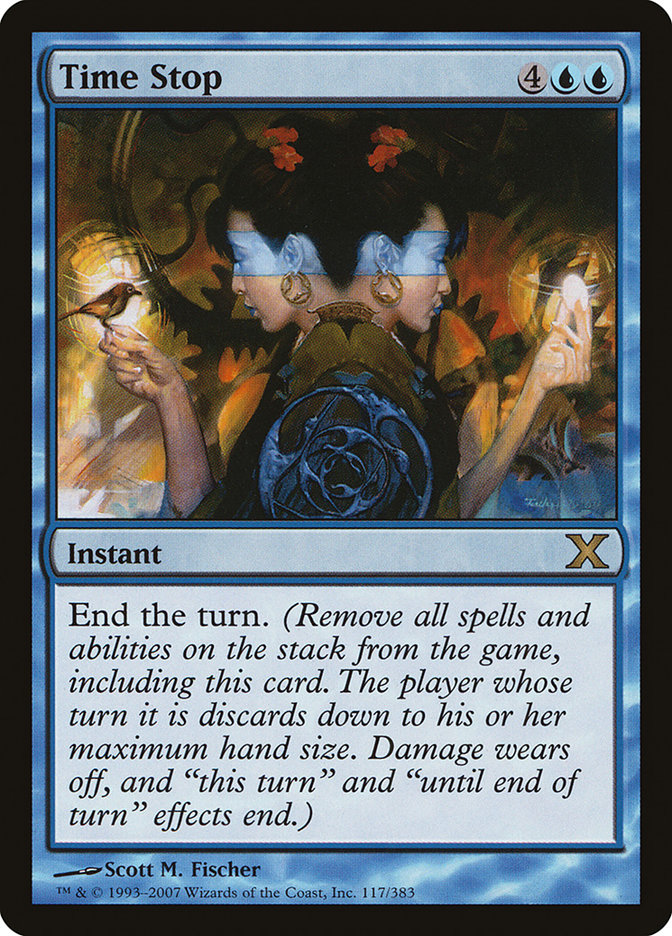 But speaking of counterspells, if we really want to have one available to us, we should have the most powerful and versatile one we can find. Time Stop is a counterspell that can handle any problem without Split Second whether that problem is even a spell or not.
But speaking of counterspells, if we really want to have one available to us, we should have the most powerful and versatile one we can find. Time Stop is a counterspell that can handle any problem without Split Second whether that problem is even a spell or not.
Is there a nasty ability firing off that you’d rather not happen, like an Oblivion Stone trying to wipe the battlefield? Time Stop can say no to that. Lethal attack headed your way? Time Stop can say no to that, too. Time Stop is a potent multitool that happens to also be a strong counterspell, and I’d rather put it to work than just plain old boring actual Counterspell. Especially since we’re light on battlefield control, this will just work so much harder than a cheap counter would have when we get to the later stages of the game.
Our last three slots are going to be dedicated to battlefield control effects to help reduce the pressure we find ourselves under. So far you only have Toxic Deluge for battlefield-wipe effects and I am assuming that one was selected because you can use it to mostly dodge your own stuff. There are a few more mass-removal effects we can deploy to accomplish that as well, with their own varying extra stipulations or costs:
Hellfire is bad against the same token hordes that Toxic Deluge is so good against, but it’s great at killing an average-sized board while leaving your own threats intact. There’s just enough lifegain in this deck already, after adding in that Disciple of Bolas, to say that we won’t even mind if this costs us ten life to cast; Sangromancer especially will be leaned on here to make Hellfire affordable. Since most of your creatures are black, this will generally wipe opposing battlefields while barely affecting yours and cost a bunch of life instead of four more mana.
We’re also including the four-more-mana option here as well, with In Garruk’s Wake playing the role of a Plague Wind that handles all opposing threats and eliminates all opposing planeswalkers as well, not bad at all for a card that currently costs less than a dollar. We can’t overload on these effects because nine mana is a lot to ask of this deck, as is ten life, so we won’t stretch further still and give that last spot to Plague Wind as well. A lower-cost supplemental element would do more for us here than another expensive sweeper; not every card has to hit a home run, some can just do good work just by trying to advance the runners.
While Grave Pact is a mana cheaper and the triple-colored-mana cost is probably not an issue, I’d rather go with Dictate of Erebos here thanks to the Flash option. Our countermagic suite are all comparable to it in cost, so we may just find ourselves holding mana open through our opponents’ turns and then dropping the Dictate onto the battlefield before untapping if we didn’t need to use the counter. Its free Edicts are going to be very valuable to us at keeping the battlefield manageable. Even though we aren’t aiming to abuse them with sacrifice outlets or by breaking its symmetry with cards like Fleshbag Marauder, we’re happy to have it just grind a little extra value for us whenever an opponent handles one of our threats or something trades off in combat.
Putting it all together, we get the following:
Creatures (31)
- 1 Solemn Simulacrum
- 1 Skeletal Vampire
- 1 Sage of Fables
- 1 Vein Drinker
- 1 Blood Tyrant
- 1 Gatekeeper of Malakir
- 1 Kalitas, Bloodchief of Ghet
- 1 Malakir Bloodwitch
- 1 Anowon, the Ruin Sage
- 1 Butcher of Malakir
- 1 Drana, Kalastria Bloodchief
- 1 Captivating Vampire
- 1 Sangromancer
- 1 Bloodlord of Vaasgoth
- 1 Adaptive Automaton
- 1 Olivia Voldaren
- 1 Rakish Heir
- 1 Evil Twin
- 1 Bloodline Keeper
- 1 Falkenrath Aristocrat
- 1 Mikaeus, the Unhallowed
- 1 Stromkirk Captain
- 1 Dark Impostor
- 1 Falkenrath Exterminator
- 1 Disciple of Bolas
- 1 Necropolis Regent
- 1 Burnished Hart
- 1 Drana, Liberator of Malakir
- 1 Olivia, Mobilized for War
- 1 Indulgent Aristocrat
- 1 Asylum Visitor
Planeswalkers (3)
Lands (29)
- 1 Reflecting Pool
- 5 Swamp
- 1 Shizo, Death's Storehouse
- 1 Minamo, School at Water's Edge
- 1 Polluted Delta
- 1 Bloodstained Mire
- 1 Watery Grave
- 1 Steam Vents
- 1 Blood Crypt
- 1 Urborg, Tomb of Yawgmoth
- 1 Graven Cairns
- 1 Sunken Ruins
- 1 Cascade Bluffs
- 1 Crumbling Necropolis
- 1 Dragonskull Summit
- 1 Drowned Catacomb
- 1 Scalding Tarn
- 1 Bojuka Bog
- 1 Command Tower
- 1 Sulfur Falls
- 1 Temple of Deceit
- 1 Temple of Malice
- 1 Temple of Epiphany
- 1 Sunken Hollow
- 1 Smoldering Marsh
Spells (36)
- 1 Sol Ring
- 1 Time Stop
- 4 Mountain
- 4 Island
- 1 Hellfire
- 1 Terminate
- 1 Future Sight
- 1 Phyrexian Arena
- 1 Neurok Stealthsuit
- 1 Mind Stone
- 1 Rhystic Study
- 1 Fact or Fiction
- 1 Dimir Signet
- 1 Izzet Signet
- 1 Rakdos Signet
- 1 Pact of Negation
- 1 Cryptic Command
- 1 Cruel Ultimatum
- 1 Soul Manipulation
- 1 Feast of Blood
- 1 Cyclonic Rift
- 1 Grave Betrayal
- 1 Hero's Downfall
- 1 Whip of Erebos
- 1 Toxic Deluge
- 1 Dictate of Erebos
- 1 In Garruk's Wake
- 1 Kolaghan's Command
- 1 Mystic Confluence
- 1 Stensia Masquerade

As always, for participating in this week’s edition of Dear Azami you will receive a $20 coupon to the StarCityGames.com Store; altogether these changes cost just under $80, and with a little luck maybe your collection or his collection will have a few of these cards sitting on the sidelines. Most of the expense was in just four cards – Tamiyo, Hellfire, Shizo, and Mystic Confluence – but the chances are decent that as a Commander player you’ll have a Rhystic Study lying around somewhere or that Time Stop might be put to work in another deck.
Breaking the changes down individually by price, we get the following:
|
Card |
Cost |
|
$0 |
|
|
$0 |
|
|
$0 |
|
|
$0.25 |
|
|
$0.25 |
|
|
$0.49 |
|
|
$0.49 |
|
|
$0.49 |
|
|
$0.49 |
|
|
$0.49 |
|
|
$0.59 |
|
|
$0.79 |
|
|
$0.79 |
|
|
$0.99 |
|
|
$0.99 |
|
|
$3.49 |
|
|
$3.99 |
|
|
$4.95 |
|
|
$9.59 |
|
|
$10.99 |
|
|
$17.99 |
|
|
$20.49 |
|
|
$78.59 |
I don’t think that complexity should be an issue here, as the only non-intuitive card we’ve added is Time Stop – it doesn’t read like a Counterspell or a Fog, but it can be either, and the fact that it exiles both any spells on the stack and itself is not intuitively obvious and takes some getting used to.
While the deck should have a good number of options to consider, especially with the different modes available to it with its power counters, it should nonetheless be easy to get the hang of – play your creatures and develop your battlefield, and then hammer down any problems that happen to get too large if the way forward is blocked. While it would be nice if your commander got the benefits of all the tribal synergies you’ve got going, she’s mostly here to cover the most predictable weakness a creature deck can have in this format by minimizing the number of cards you actually lose to a mass removal effect.
I think this should be a bit more fun and a lot more powerful, but without the excess complexity you’re worried might get in the way of an enjoyable game. There are complicated cards, it’s true, but each of them has a common best use that will generally remain true each time it is encountered, and since the deck has a specific focus it’s not hard to follow where everything else is pointing. Everything is aimed straight at an opponent’s neck, and it should draw a sufficient amount of blood to make the games both enjoyable and competitive.
Want to submit a deck for consideration to Dear Azami? We’re always accepting deck submissions to consider for use in a future article, like Juan’s Gisa and Geralf deck or Beth’s Thalia, Heretic Cathar deck. Only one deck submission will be chosen per article, but being selected for the next edition of Dear Azami includes not just deck advice but also a $20 coupon to StarCityGames.com!
Email us a deck submission using this link here!
Like what you’ve seen? Feel free to explore more of Dear Azami here, in the Article Archives! And feel free to follow Sean on Facebook… sometimes there are extra surprises and bonus content to be found over on his Facebook Fan Page as well as previews of future columns!


